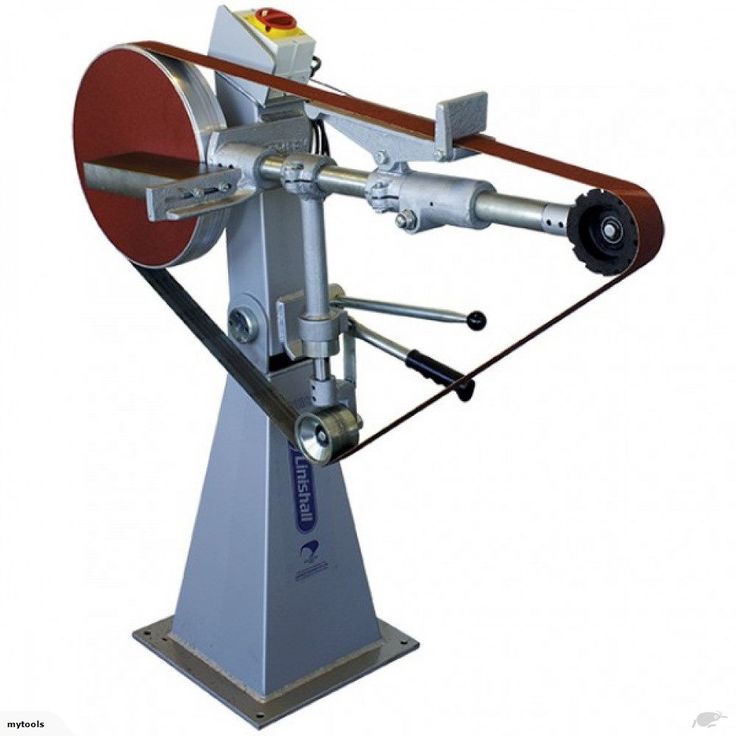-
Welcome back Guest! Did you know you can mentor other members here at H-M? If not, please check out our Relaunch of Hobby Machinist Mentoring Program!
You are using an out of date browser. It may not display this or other websites correctly.
You should upgrade or use an alternative browser.
You should upgrade or use an alternative browser.
Speed control on a grinder?
- Thread starter Aaron_W
- Start date
- Joined
- Apr 14, 2014
- Messages
- 3,153
Same here. I use the 6"x 48" or 12" disk for larger stock, and the 1"x 42" for the smaller stuff. The 1"x 42 works great for sharpening mower blades. Much easier to maneuver the longer ones into the proper position. I also like the fact that it only takes a few seconds to change belts on the smaller machine. Sometimes locating and tensioning the 6"x 48" belt can be a real PITA.I have a 6 x 48 belt grinder with a 12" disc which I use a lot, and I use to have a 1 x 42 belt grinder, and neither one have variable speed and I never had a desire to have variable speed.
Ted
One thing I noticed a while ago when looking for belts for the 1"x 42" is that machines listed as "belt sanders" usually have speeds around 8,000 SFPM and use relatively low hp high rpm (3450) motors. Those listed as "belt grinders" usually run at 4,000 SFPM or less and use more powerful lower rpm (1725) motors.
Having said that there are certainly marketers willing to list their machines in whatever category they think they will sell the greatest numbers.
- Joined
- Sep 29, 2017
- Messages
- 2,251
I am busy building a 2×72 using what I have, which is a 2hp 1400rpm motor and a 6.69" (170mm) drive wheel. I wil mostly grind HSS and mild steel with ceramic belts. Will this be good enough? I saw two different formulas for sfpm, one is sfpm= rpm × .262 × tool diameter (6.69") the other is sfpm= (pi × drive wheel diameter) × motor rpm.
They give very different answers,so now I am not sure.
My other problem is the correct tension for the belt. Some say 60lb and other say 30lb is enough,which is it?
Sorry for the hijacking of the post @Aaron_W
They give very different answers,so now I am not sure.
My other problem is the correct tension for the belt. Some say 60lb and other say 30lb is enough,which is it?
Sorry for the hijacking of the post @Aaron_W
- Joined
- May 7, 2023
- Messages
- 1,344
To make things even more fun there’s also this doohickey called a linishing machine.Same here. I use the 6"x 48" or 12" disk for larger stock, and the 1"x 42" for the smaller stuff. The 1"x 42 works great for sharpening mower blades. Much easier to maneuver the longer ones into the proper position. I also like the fact that it only takes a few seconds to change belts on the smaller machine. Sometimes locating and tensioning the 6"x 48" belt can be a real PITA.
One thing I noticed a while ago when looking for belts for the 1"x 42" is that machines listed as "belt sanders" usually have speeds around 8,000 SFPM and use relatively low hp high rpm (3450) motors. Those listed as "belt grinders" usually run at 4,000 SFPM or less and use more powerful lower rpm (1725) motors.
Having said that there are certainly marketers willing to list their machines in whatever category they think they will sell the greatest numbers.

Makes uniform surfaces via blending.
3.14 x 6.69" x 1400rpm = 29,409 inches per minute. Divided by 12 for FPM belt speed = 2450sfpm= (pi × drive wheel diameter) × motor rpm.
They give very different answers,so now I am not sure.
- Joined
- Jan 2, 2019
- Messages
- 6,526
I’m finally putting my 2x72 together. Might have gone different on the motor if this thread had been earlier but settled on a 2hp Baldor TEFC with VFD drive. If nothing else it’ll allow for faster speeds with ceramic belts.
Looking forward to answering the variable speed question for myself.
John
Looking forward to answering the variable speed question for myself.
John
I use the variable speed on my 2x72 grinder frequently. It's used for both wood and metal, and if using the small wheel attachment( which I do at times), you just about have to slow it down, or you'll burn out the bearings. Also use Scotch-Brite( aka surface conditioning ) belts, and find that slowing it down for them is a good thing also. It all boils down to what you're using it for. Build it for you, not what others think you should do. I can't imagine not having the feature, for my purposes.

